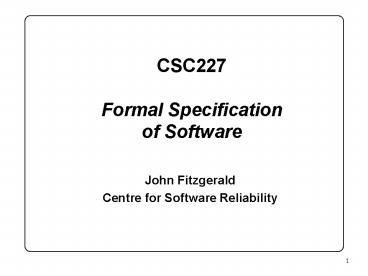CSC227 Formal Specification of Software - PowerPoint PPT Presentation
1 / 18
Title:
CSC227 Formal Specification of Software
Description:
Formality. Formal specification languages. The structure & content of CSC227. 3 ... Formality. This course concentrates on formal languages for expressing models. ... – PowerPoint PPT presentation
Number of Views:201
Avg rating:3.0/5.0
Title: CSC227 Formal Specification of Software
1
CSC227Formal Specification of Software
- John Fitzgerald
- Centre for Software Reliability
2
Software Todaywhy we need to model systems
- Challenges in software development
- Modelling Computing Systems
- Formality
- Formal specification languages
- The structure content of CSC227
3
Characteristics of Software
We build computing systems out of software -
engineers in other disciplines use physical
materials like steel, electronic devices or
advanced materials. What makes software different?
4
Software Today challenges
Technological you can do more in software than
before Software is often used for critical
tasks. Name some safety- or security-critical
applications
5
Software Today challenges
Economic Challenges the cost of rework Software
development takes place on a huge scale, and
often goes wrong! How much software gets used as
delivered?
6
Software Today challenges Rework Costs
Requirements Analysis
Acceptance Test
System Specification
System Test
System Design
Integration Test
Software Design
Unit Test
Software implementation
7
Software Today challenges Rework Costs
- The rework cost to fix a bug is related to
distance between the commission and the
discovery of the error. - Improved analysis of requirements and designs
could reduce the rework costs for some of the
most expensive errors. - CSC227 is about a particular class of techniques
which help us to do this kind of analysis.
8
Modelling Computing Systems
In other engineering disciplines (Mechanical,
Electrical, Aeronautical etc.) system models are
built to help gain confidence in requirements and
designs. For example In this course, we
will look at how we can build and analyse models
of software. There are two characteristics of
these models which are crucial to their
successful use abstraction and rigour.
9
Modelling abstraction
Engineering models omit details which are not
relevant to the purpose of the model. For
example The omission of detail not relevant
to a models purpose is called abstraction. The
choice of which details to omit is a matter of
engineering skill.
10
Modelling abstraction
Compare these extracts from two descriptions of
the same system. The FlightFinder System is to
be used by travel agents and their customers.
Details are entered, including point of
departure, destination, preferred dates and
times. He system will respond with a range of
itineraries and fares, along with the relevant
restrictions. The system record locations as
nodes in a connected graph structure. Each node
struct contains an array of pointers to reachable
destinations plus, for each pointer, a timetable
of flights stored as a hash table. Each record in
the hash table has a flight number (8 character
string), departure and arrival times (standard
time formats) and operating dates (standard date
format). To obtain the optimal route, the graph
must be traversed using a shortest path algorithm
on a modified adjacency matrix ...
11
Modelling rigour
The most important property of a model of a
computing system is its suitability for analysis.
The analysis must be objective (not down to the
opinion of the individual engineers performing
it). It should also be repeatable and susceptible
to machine support. The language in which a
model is expressed should be rigorously defined
little room for disagreement about what a model
actually says analysis tools reach the same
conclusion about the properties of models. Many
programming language have non-rigorous
definitions. What is the consequence?
12
Modelling computing systems
How do these concepts of system modelling
transfer to software development? A range of
modelling techniques are used in software
development Models constructed in early
development stages are specifications those
developed in later stages are designs. We will
generally be concerned with specifications
(because of the importance of modelling in early
development stages) but we will tend to use the
term model to refer to the system descriptions
that we develop.
13
Formality
This course concentrates on formal languages for
expressing models. A language is formal if its
syntax rules and its semantics (the meaning of
every construct in the language) are so precisely
defined that there is no room for disagreement
about the meaning of a model. Models expressed in
a formal language are susceptible to a wide range
of analysis techniques including mathematical
proof (we can, in principle, prove that a model
embodies a property such as safety or indeed
prove that a program is correct with respect to a
specification).
14
Formal Specification Languages
A formal specification language is a formal
language used for expressing models of computing
systems. Such languages typically provide support
for abstraction and rigour.
General Purpose VDM-SL Z RSL Act One Clear
Special Purpose CCS CSP Real-Time Logic Deontic
Logics
15
Formal Specification Languages VDM-SL
- Vienna Development Method (VDM)
- Spec Language is VDM-SL
- ISO Standardised fully formal
- Support Tools are available
- Good record of industrial use
- Support for abstraction of data and functionality
16
Course Structure
- Introduction
- Guided Tour through a formal model
- Logic
- Basic abstractions
- Principal abstractions sets, sequences, mappings
- State-based and functional styles
- Validation
17
Course Principle
- Formal Methods are part of practical Systems
Engineering, not theoretical Computing Science! - All our examples are based on real formal models
developed in a commercial context. - We will use examples and exercises extensively
to give a strong flavour of the modelling skills
used.
18
CSC227 Arrangements
- Lectures
- Coursework
- An individual exercise book (60)
- A group-based modelling problem (40)
- Text Fitzgerald Larsen, Modelling Systems
Practical Tools and Techniques in Software
Development, Cambridge Univ. Press 1998, ISBN
0-521-62348-0 - Web http//www.csr.ncl.ac.uk/modelling-book/































